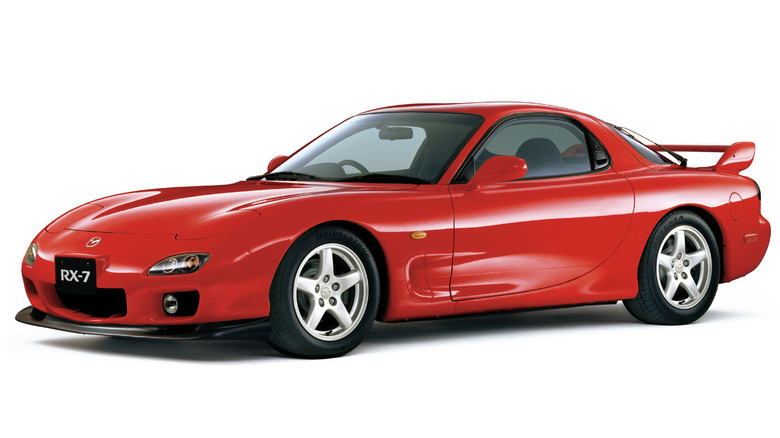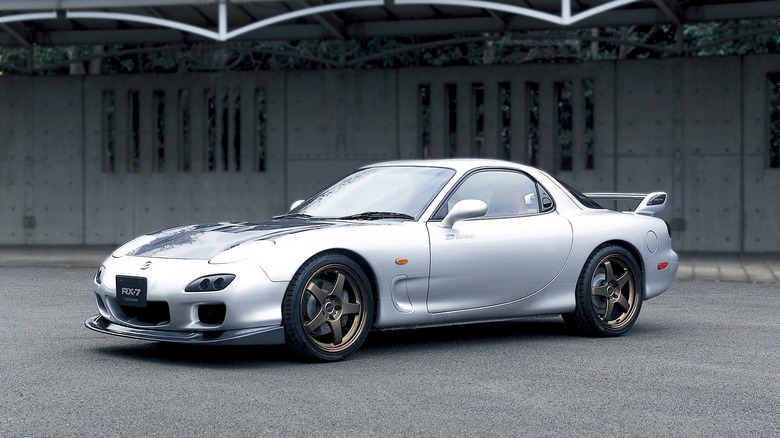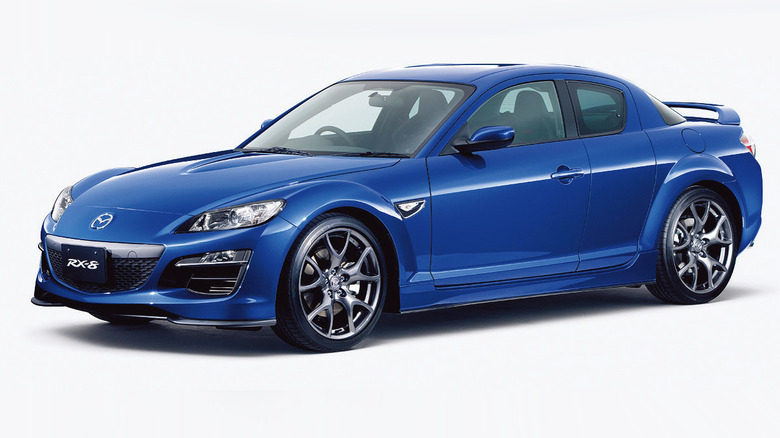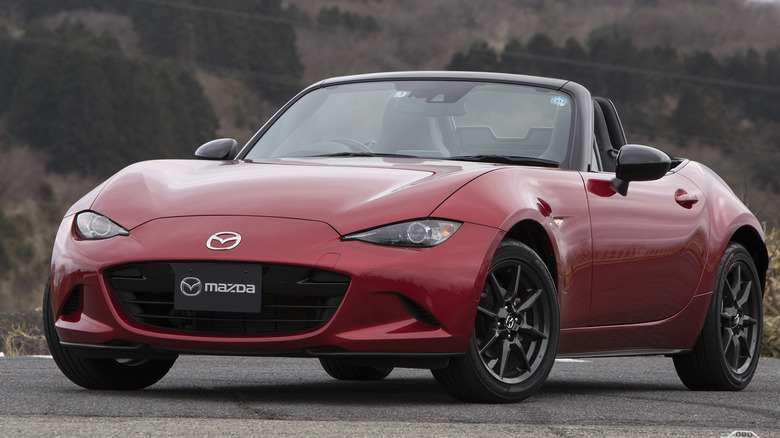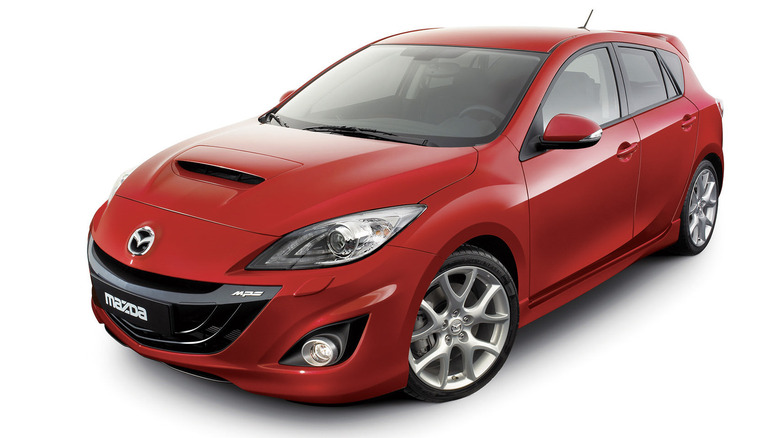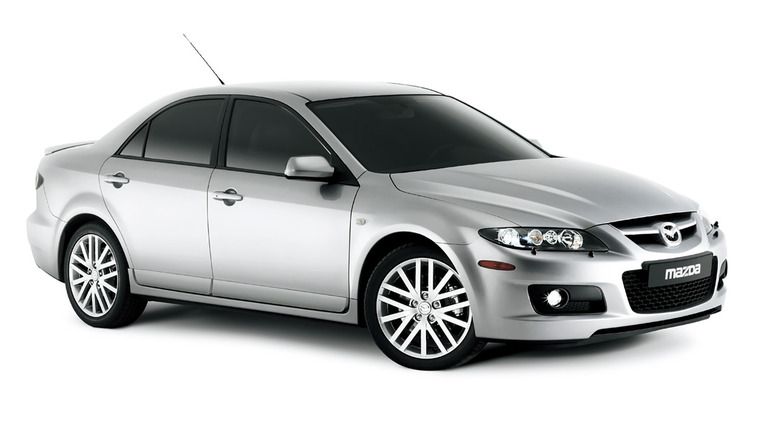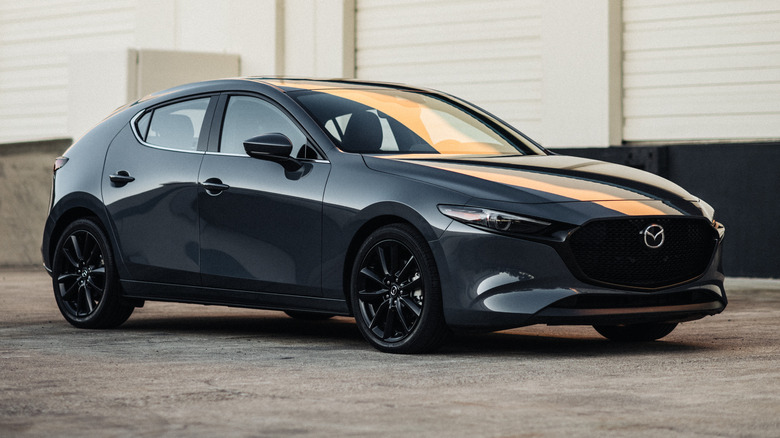6 Of The Fastest Mazda Sports Cars Ever Made
Mazda doesn't make any particularly sporty cars today other than the Miata (also known as the MX-5), but it has made its fair share of enthusiast-pleasers throughout its history. Most have been front-engined, rear-wheel drive sports cars, but it's also made fun front-well drive cars, as well as one rather cool all-wheel drive performance sedan.
The manufacturer's performance offerings used to be defined by the Wankel rotary engine that powered its most hardcore models. The rotary engine was phased out in 2012 when the RX-8 was discontinued, but it's such a big part of Mazda's image that the manufacturer has now brought it back as a range extender for its MX-30 electric vehicle.
Interestingly, Mazda didn't employ turbocharging in most of its iconic performance models, except for some versions of the RX-7. What enthusiasts liked most about Mazda's sporty road cars with rotary engines was not the outright pace but rather their ability to rev smoothly and cleanly to well over 7,000 rpm.
The manufacturer has mostly stuck to that philosophy of not offering turbocharging except its most potent offerings, bucking the industry trend towards downsized, force-fed engines. Today, it offers a pair of turbocharged engines, and both are capable of delivering excellent performance.
Now that you know the brief history behind Mazda sports cars, lets take a look at the six fastest ever made.
RX-7 FD
The RX-7 FD, built from 1992 until 2002, is the most extreme Mazda road car ever and also the model that saw the most attention from tuners, especially after some movie appearances, like in the "Fast and the Furious" series. It is the third RX-7 generation, and not only did it look like a proper, low-slung, sporty coupe, but it had the firepower to match.
Under its hood was the 13B-REW twin-turbo rotary engine, which initially produced 255 horsepower but was upgraded in 1996 to make 276 horsepower, just under the 280 horsepower limit that all Japanese manufacturers had agreed to in the 1990s.
The more powerful version was capable of sprinting from zero to 60 mph in under four seconds, making it the quickest-accelerating Mazda road car ever. It was also appreciated for its low weight and nimble handling, and examples equipped with the optional R1 and R2 packs (that improved the cars' aero, suspension, and chassis) were seen as exceptional drivers' cars for the day.
RX-8
Mazda's last attempt to put a rotary engine in a sports car saw mixed results. The RX-8 was designed from the ground up as a sports car, and this showed in its ability to devour a mountain road even in stock form. It also had to be a much more competitive offering than any previous Mazda sports car since there were so many rivals it was going up against, from the likes of Porsche, Nissan, Audi, BMW, and Mercedes-Benz.
The RX-8 was introduced in 2002, the same year the RX-7 was discontinued, but it was not pitched as a direct replacement. It was a less powerful, more affordable, and non-turbo Wankel-powered car designed to appeal to those who weren't looking to spend Porsche money on a Mazda.
Powering the RX-8 was a twin-rotor rotary mill called Renesis, which came in two- and four-port configurations. Initial two-port versions made 192 horsepower, while the four-port version upped that to 238 horsepower. Mazda subsequently launched a revised version of the engine, which got slightly more power and a higher 8,500 rpm redline. It was able to send the RX-8 to 60 mph in around six seconds and on to a top speed of 147 mph (237 km/h). It was discontinued in 2012 when the engine's poor reliability reputation and high fuel consumption prompted Mazda to pull the plug on the model.
Miata (MX-5)
The most famous sporty isn't an RX model but an MX model, the MX-5. Known in the U.S. as the Miata, the four versions of this pint-sized and featherweight drop-top have accumulated millions of sales, making it the single most popular roadster in history.
Sheer acceleration was never the Miata's main goal, so it was never offered with particularly powerful engines. Mazda never officially sold it with a rotary engine, offering it exclusively with naturally aspirated four-cylinder engines ranging in displacement from 1.5 to 2 liters.
The latest (fourth generation) Miata, known as the ND, is the best one so far. It is the quickest, stiffest, safest, and most enjoyable to drive. It's truly remarkable how Mazda has continually improved the MX-5 formula and still sold a vehicle in 2023 with a very similar driving experience to the 1990s original.
Sheer acceleration isn't the MX-5's strong suit, but the latest incarnation of the model, updated in 2023, has a 2-liter engine with 181 horsepower. It can push the Miata's tiny 2,200-pound body to 60 mph in 5.8 seconds and on to 136 mph (219 km/h) flat out.
MazdaSpeed 3
The MazdaSpeed 3 (known as the Mazda 3 MPS in Europe and other markets where the acronym stood for "Mazda Performance Series") is considered a true hot hatch. It was available for two generations, the first running from 2007 to 2009 and the second from 2010 until 2013.
Both were front-wheel drive and had a 2.3-liter, four-cylinder turbocharged engine, which made 263 horsepower and 280 pound-feet of torque. The engine was the star of the show with the Mazda 3 MPS, and it was awarded an important distinction when it was picked as one of Ward's 10 Best Engines of 2008.
Once you got used to the car's heavy torque steer under hard acceleration, you left to discover a very sweet-handling package, one that could rival the best hot hatches of the era. This isn't surprising given that the Mazda 3 of the era was based on the Ford Focus, which was acknowledged as the most fun and engaging car to drive in its class.
MazdaSpeed 6
Another lesser-known application of the award-winning 2.3 MZR DiSi engine that powered the MazdaSpeed 3 was in the larger MazdaSpeed 6 sedan (known as the Atenza in Japan). This application powered a one-size-class-up sedan compared to the MazdaSpeed3, a car with all-wheel drive and a more relaxed character than the fire-breathing front-driven hot hatch.
The engine's power was boosted to 274 horsepower, but torque stayed the same at 280 pound-feet. Interestingly, even though the Mazda 6 sedan was a considerably bigger and heavier vehicle than the Mazda 3, thanks to standard all-wheel drive, the hot sedan posted a very similar zero to 60 time to the hot hatch, recording a time of 6.2 seconds.
It, too, was a great-handling, chuckable driver's car with more than enough power to feel enjoyable, but it ultimately proved unsuccessful. Its all-wheel drive Japanese performance sedan rivals Mitsubishi and Subaru; they were more hardcore offerings, and thanks to their connection to the world of rallying, they had a much better image, too.
Mazda 3 Turbo
Mazda still makes a spicy hatchback model, the Mazda 3 Turbo, which has much of the appeal of the original MazdaSpeed 3 but is in a more grown-up package. It's powered by a new 2.5-liter turbocharged four-cylinder engine that makes 250 horsepower and a very healthy 320 pound-feet (435 Nm) of torque (if you fill it up with premium gasoline, otherwise the values drop to 227 horsepower and 310 pound-feet).
It accelerates to 60 mph in under six seconds, matching the more powerful MazdaSpeed3 thanks to the extra traction provided by all-wheel drive. Enthusiasts might have an issue with the fact that Mazda doesn't offer a turbo with its excellent six-speed manual transmission (that you can get in the 191-horsepower non-turbo version of the car). However, even with the standard automatic, the car is still quite enjoyable to drive.
With the sure-footedness of the all-wheel drive system, the force-fed version of the latest Mazda 3 hatchback is nowhere near as wayward feeling as the MazdaSpeed 3 when driven hard, but by modern standards, it would still be described as a fun-to-drive compact car.
